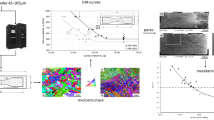Abstract
The mass of high-performance components can be reduced by the use of materials with a high ultimate strength. However, due to increasing demands on the performance of such components this design strategy reaches its limits, especially if certain parts of the components demand special physical properties. Therefore, in a load-dependent strategy hybrid components out of compounds are used. Through this, suitable materials are placed in the highly loaded component areas. This contribution presents results of experimental investigations of the tool behavior when milling compounds. The focus is on tool wear during face slab milling of a compound out of an aluminum alloy and a spheroidal cast iron. In order to distinguish between the thermal and mechanical influences on the tool wear, different material combinations are used. The influence of tensile strength is studied during the milling of materials with the same heat conductivity (GJS400/GJS600), while the influence of the heat conductivity is examined with materials with comparable tensile strengths (AW2030/GJS400).














Similar content being viewed by others
References
Altenburg K (1998) Neue Wege im Schienenfahrzeugbau: Modulare Hybridbauweise. Funktionsintegrative Hybridstrukturen in Leichtbauweise
Friedrich H, Steig J (1998) Innovative Faserverbund-Strukturen im Fahrzeugbau. 4. Nationales SAMPE Symposium, Innovative Faserverbundstrukturen in Verkehrstechnik und Luftfahrt
Klemm H (2004) Heimliche Gewinner. MM Maschinenmarkt––Das Industrie Magazin
Boehnke D (2007) Qualitätsorientierte Zerspanung von Parallelverbunden im kontinuierlichen Schnitt, Dissertation
Arendts FJ (1992) Aktuelle Entwicklungen in der Strukturtechnik. Zeitschrift für Flugwissenschaften und Weltraumforschung
Getzlaff U, Göpfert M (2006) Konfliktlösung zwischen Bauteilbelastung und Bauteilgewicht durch Materialkombinationen
Denkena B (1992) Verschleißverhalten von Schneidkeramik bei instationärer Belastung, Dissertation
König W (1966) Der Werkzeugverschleiß bei spanender Bearbeitung von Stahlwerkstoffen
Ludwig H-R (1989) Beanspruchungsanalyse der Werkzeugschneiden beim Stirnplanfräsen, Dissertation
Shaw MC (1971) Fundamentals of Wear. Ann CIRP XVIV:533–543
Ziebeil F (1995) Mechanische und thermische Belastung von Zerspanwerkzeugen, Dissertation
Tönshoff HK, Denkena B (2004) Spanen. Springer, Berlin
Acknowledgments
The present work is supported by the German Research Foundation (DFG) within the project ‘‘Tool behavior at alternating thermo-mechanical loads during milling of compounds’’. The authors thank the DFG for the financial support and the LWM, Technical University Chemnitz, for the pleasant cooperation.
Author information
Authors and Affiliations
Corresponding author
Rights and permissions
About this article
Cite this article
Denkena, B., Boehnke, D. & Dziewiecki, P. Tool behavior at alternating thermo-mechanical loads during milling of compounds out of aluminum and spheroidal cast iron. Prod. Eng. Res. Devel. 2, 351–356 (2008). https://doi.org/10.1007/s11740-008-0124-2
Received:
Accepted:
Published:
Issue Date:
DOI: https://doi.org/10.1007/s11740-008-0124-2




